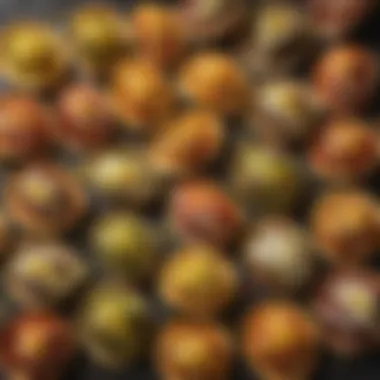Understanding Carbohydrate Content in Taco Shells


Intro
In today’s culinary landscape, understanding nutritional content is crucial. Particularly regarding taco shells, there is an important need to explore their carbohydrate levels. Taco shells are often made from different ingredients, leading to variations in carb counts that can impact dietary choices. This article provides insights into the diverse types of taco shells available in the market, their carbohydrate content, and how to make informed choices while meal planning.
By grasping the differences in carbohydrate content, culinary enthusiasts and health-conscious individuals will come to appreciate not only the nutritional aspects but also how these choices play a role in their overall health. Understanding carbohydrate content is not merely an exercise in number counting; it bears implications for anyone who endeavors to maintain a balanced lifestyle while indulging in flavorful dishes.
Recipe Overview
Recipe Name
Taco Shells – A Comprehensive Guide
Description of the Dish
Taco shells serve as the canvas for countless flavor combinations, ranging from meat to vegetables to beans. They can be made from traditional corn or flour options and form the base of numerous delicious meals. Understanding the carbohydrate content of these shells can greatly aid in meal preparation and dietary planning.
Preamble to Taco Shells and Carbohydrates
Taco shells are a staple in many culinary traditions, particularly in Mexican cuisine. They serve as the vessel for various fillings, from savory meats to fresh vegetables. Understanding the carbohydrate content in taco shells is vital for those who are health-conscious or following specific diet plans. Carbohydrates play a significant role in providing energy, and their type and quantity can impact overall health, making it essential to analyze what is consumed.
The Importance of Carbohydrate Counting
Carbohydrate counting can be crucial, particularly for individuals managing conditions like diabetes. It involves monitoring the number of carbs consumed to help maintain stable blood sugar levels. Taco shells often vary in their carbohydrate content, depending heavily on their ingredients. For instance, corn shells typically exhibit different carb levels compared to flour shells. This variability means that understanding the nutritional value of each type aids in maintaining dietary goals.
Furthermore, recognizing the presence of simple versus complex carbohydrates can inform choices that impact weight management and energy levels. Simple carbohydrates, often found in processed foods, may cause rapid spikes in blood glucose. In contrast, complex carbohydrates tend to provide longer-lasting energy.
The insight gained from assessing carbohydrate content not only contributes to better health management but also enhances meal planning. By being informed, individuals can enjoy their meals without compromising nutritional balance.
Overview of Taco Shell Varieties
Taco shells come in an array of varieties, each differing in both texture and nutritional profile. The two most common types are corn and flour shells. Corn taco shells are often seen as traditional, made primarily from masa harina. Flour tortillas, on the other hand, are made using wheat flour and tend to be more pliable, providing a different eating experience.
In addition to these standard types, the market offers a growing selection of alternatives. For those looking to avoid gluten, corn shells provide a viable option. There are also innovative substitutes like lettuce wraps and grain-free options, appealing to a broader audience concerned with health and dietary needs.
Understanding these varieties is crucial when assessing carbohydrate content. Different types inherently possess distinct nutritional profiles. In turn, this affects how they should be incorporated into a balanced diet. Ultimately, knowing the differences aids consumers in making educated decisions regarding their food choices.
Nutritional Breakdown of Taco Shells
Understanding the nutritional breakdown of taco shells is crucial for people who are conscious about their dietary intake, particularly carbohydrate content. Carbohydrates constitute a significant part of our diet, acting as a primary energy source. Taco shells, being a fundamental component of Mexican cuisine, can vary widely in their carb content depending on the ingredients and type. This section will clarify the nutritional properties of different taco shell varieties, aiming to help readers make informed choices for their meals.
Standard Corn Taco Shells
Typical Carbohydrate Content
The typical carbohydrate content in standard corn taco shells is generally around 12-15 grams per shell, depending on the brand and size. This number plays an essential role in meal planning, especially for individuals tracking their carbohydrate intake. The primary feature of corn taco shells is the type of corn used, which influences their flavor and nutrition.
Corn tortillas are often viewed as a beneficial choice due to their whole grain content. This allows for a richer nutrient profile. They are not only lower in calories than some alternatives, but they also provide fiber, which is essential for digestive health. However, some people may find corn taco shells less satisfying due to their texture compared to flour options.
Other Nutritional Components
Beyond carbohydrates, standard corn taco shells offer various other nutritional components. Most notably, they contain small amounts of protein and fiber, making them more nutritious than simple carbohydrate sources. Additionally, they provide a certain level of essential minerals, such as magnesium and phosphorus.


The key characteristic of these taco shells is that they are typically lower in fat compared to their flour counterparts. This can be advantageous for those watching their fat intake. However, some corn taco shells may contain preservatives or additives that could detract from their health benefits. Thus, it's wise for consumers to read ingredient labels carefully when selecting products.
Flour Taco Shells
Comparative Carb Levels
When comparing flour taco shells to corn varieties, the carbohydrate levels can be considerably higher, often ranging between 15-20 grams per shell. This increase is primarily due to the use of refined wheat flour, which has a higher carbohydrate count. The appeal of flour taco shells comes from their softer texture, which some individuals prefer for holding fillings more securely.
The notable feature of flour taco shells is their chewy consistency, which enhances the eating experience. However, their higher carbohydrate content may pose challenges for those on low-carb diets. Includes numerous options benefits individuals seeking a more traditional taco experience, especially for dishes like soft tacos or burritos.
Nutritional Advantages and Disadvantages
Flour taco shells have both advantages and disadvantages in relation to nutritional content. On the positive side, they are typically richer in protein than corn shells, which can enhance the satiety factor of a meal. Additionally, their versatility allows them to serve not just as taco shells, but also as wraps for different types of cuisine.
On the downside, the refined nature of the flour used often results in lower fiber content, contrary to whole grain corn shells. This means that while they can be more filling, they do not provide the same digestive benefits. Moreover, individuals with gluten sensitivities or celiac disease should avoid flour taco shells altogether to prevent adverse health reactions.
Alternative Taco Shells
Lettuce Wraps
Lettuce wraps have become a popular alternative for those looking to reduce carbohydrate intake significantly. Using lettuce instead of a traditional shell can cut the carb count to nearly zero, depending on the type of lettuce. The appeal of lettuce wraps lies in their crisp texture and freshness. They are an excellent option for anyone following a low-carb or keto diet.
However, while they are refreshing, lettuce wraps may not provide the same level of satisfaction as classic taco shells. The lack of a solid structure can lead to messy eating, and they often do not hold fillings as well, which could detract from the overall taco experience.
Grain-Free Options
Grain-free taco shell options are designed for those avoiding gluten or grains altogether. These can include shells made from nuts, coconut, or a blend of non-grain ingredients. The carbohydrate content varies widely based on what ingredients are utilized. Many grain-free options are higher in protein and healthy fats, making them a compelling choice for those concerned about sugar and insulin spikes.
However, the flavor and texture may differ significantly from that of conventional taco shells. Some people might find these options less enjoyable, despite their health benefits.
Vegetable-Based Shells
Vegetable-based shells, such as those made from zucchini or other vegetables, present another alternative. They provide numerous vitamins and minerals while keeping carbohydrate levels low. The unique feature of vegetable-based shells is their vibrant appearance and potential for incorporating a variety of flavors into a dish.
Nevertheless, like lettuce wraps, vegetable-based options can sometimes sacrifice structural integrity. They may not contain enough firmness to support heavy fillings, which could lead to a less conventional taco experience. Moreover, they tend to be more labor-intensive to prepare, which could be a consideration for home cooks.
Factors Influencing Carbohydrate Content
Understanding what influences carbohydrate content in taco shells is essential for making informed dietary choices. Different factors such as ingredients and cooking methods significantly impact the final nutritional profile of these popular items. Knowing these elements allows individuals to adjust their meals according to their health goals, dietary restrictions, or personal preferences.
Ingredients Used in Taco Shell Production
The ingredients in taco shells dictate their carbohydrate levels significantly. Traditional taco shells are often made from corn or flour, but variations exist and can include other grains or alternative bases.
- Corn: Most common; typical corn taco shells contain about 12-15 grams of carbohydrates per shell. The processing of corn into masa harina (dough) can alter the nutrition profile slightly.
- Flour: Flour taco shells tend to have a higher carbohydrate content, often ranging from 20-25 grams per shell. The kind of flour used, whether white or whole wheat, also influences the nutritional values.
- Alternative Ingredients: Some brands or homemade recipes incorporate ingredients like almond flour or coconut flour. These options can lower carbohydrate content. For example, a coconut flour shell might have around 5-10 grams of carbs per shell, appealing to low-carb dieters.
Use of fillers or enhancers during production can also increase carb levels unknowingly. For instance, taco shells with added sugars or starches will contribute additional carbohydrates that may not be immediately evident on nutrition labels.
Impact of Cooking Methods
Cooking methods also play a role in determining the carbohydrate content of taco shells, although this factor is less direct. Common methods include frying and baking.


- Frying: When taco shells are fried, they may absorb oil, which can add calories but typically does not affect the carbohydrate count. However, fried shells might encourage added toppings that further increase the overall carbohydrate content.
- Baking: Baking tends to preserve the existing carbohydrate levels and can result in a lighter shell. Baking instead of frying is often recommended for health-conscious consumers since it keeps fat content down.
A surprising aspect is that overcooking taco shells may lead to slight nutritional changes, including the potential degradation of some carbohydrates into simpler forms. This view emphasizes that both preparation and cooking time matter in how our food interacts with our bodies.
In summary, the carbohydrate content of taco shells is influenced not only by the ingredients used but also by how they are made and prepared. Recognizing these factors can help consumers align their taco choices with their health objectives.
Evaluating Taco Shell Brands
Evaluating taco shell brands is critical for those who prioritize understanding the carbohydrate content in their food. Some brands emphasize unique ingredients, while others use common staples. The differences can notably affect your carb intake. Moreover, familiarizing oneself with various brands can help consumers make better choices based on their dietary needs and preferences.
Comparative Analysis of Popular Brands
When examining popular taco shell brands, it is essential to consider their carbohydrate content as well as their overall nutritional profile. For instance, brands like Old El Paso and Mission both offer a selection of traditional corn and flour shells. Corn taco shells generally contain fewer carbs compared to flour shells. However, it is worth noting that the actual carb count can differ based on the specific product line and size of the shell.
Another brand worth mentioning is Taco Bell, which has ventured into the market of pre-packaged taco shells. Their offerings can also provide comparative insights into the carb values. It is crucial to check the serving sizes and ingredients to ensure a fair comparison, as these factors can skew perceptions of which brand is the healthiest option.
Thus, when choosing a brand, looking beyond flavor is vital. Evaluating nutritional value can have substantial effects on meal planning and dietary goals.
- Key Considerations:
- Check the serving sizes for accurate carb counting.
- Evaluate the ingredient lists for any unwanted additives.
- Compare the variations between corn, flour, and alternative options.
Understanding Labels and Claims
Understanding labels and claims is perhaps one of the most vital aspects of evaluating taco shell brands. Labels carry significant information regarding food content, including carbohydrates, calories, and allergens. By law, companies must provide specific nutritional information on their packaging.
Consumers should focus on both the Nutrition Facts and Ingredient List. The former gives a clear view of total carbohydrates, while the latter informs about the types of carbs present, like added sugars or fibers.
A common pitfall is the interpretation of health claims. Many brands may label their products as "gluten-free" or "natural," which can mislead consumers when it comes to actual carbohydrate content. Always cross-reference such claims with standard nutrition information.
"Understanding food labels is more than a routine; it is a skill that can shape dietary choices effectively."
Taco Shells and Dietary Considerations
When discussing taco shells, it is essential to address how they fit into various dietary frameworks. This section will illuminate the importance of selecting the right taco shell depending on individual health needs. Awareness of carbohydrate content and other nutritional factors can significantly influence meal planning and overall dietary health.
Low-Carb Diets and Taco Shell Options
Low-carb diets have gained popularity for their potential to aid in weight management and metabolic health. These diets often restrict high-carbohydrate foods, prompting individuals to seek alternatives that align with their goals.
When it comes to tortilla choices, options such as lettuce wraps or grain-free shells are alternatives many people consider. Lettuce wraps provide a fresh, crunchy base without the excess carbohydrates.
Alternatively, products like almond flour or coconut flour taco shells have emerged. These grain-free varieties generally contain fewer carbohydrates than traditional corn or flour shells. However, always check labels. Some brands may misinterpret carb levels due to added ingredients.
Gluten Sensitivity and Corn Variants
Gluten sensitivity is a notable concern for many consumers. For those who cannot tolerate gluten, corn taco shells are often a suitable option. Corn is naturally gluten-free, making it a popular choice for individuals with celiac disease or gluten intolerance.
Nevertheless, the type of corn used can vary. Some mass-produced taco shells may carry cross-contaminated grains or additives that could trigger a gluten reaction in sensitive individuals. Hence, reading the packaging is crucial. Brands like Mission and Old El Paso offer gluten-free options and safe alternatives for people who need them.
Caloric Intake and Meal Planning


Understanding caloric intake is vital for meal planning. Taco shells contribute a significant portion of total calories in a taco meal. Choosing the right shell can help balance caloric intake while satisfying hunger and nutritional needs. Standard corn taco shells have about 50-60 calories per shell, while flour varieties can range from 90 to 120 calories or more.
To make a healthier choice, consider the following tips:
- Opt for smaller shells when portioning meals.
- Use fewer shells and bulk up fillings with vegetables.
- Pair with lean proteins like chicken or turkey to create a fulfilling meal.
The key is moderation and balance. Choosing lower-calorie taco shells and filling them with nutrient-dense ingredients can create a satisfying meal without overloading on calories.
Informed Taco Consumption
Informed taco consumption is vital in today’s dietary landscape, where knowledge of food content significantly influences health choices. It empowers individuals to make educated decisions about the types of taco shells they consume and their accompanying ingredients. Understanding the carbohydrate content in tacos helps to balance dietary needs with personal preferences.
Through informed consumption, one can appreciate the interplay between different components of a meal and their nutritional effects. This knowledge also contributes to meal planning, allowing individuals to fit their taco choices within their overall dietary goals.
Portion Control and Serving Sizes
Portion control plays a crucial role in managing carbohydrate intake. Serving sizes for taco shells can vary widely, so being aware of these differences is necessary. Commonly, a standard corn taco shell may pack around 15 grams of carbohydrates, while a flour taco shell can double that amount.
Proper portioning helps prevent the accidental over-consumption of carbohydrates. Using smaller taco shells can allow for a variety of fillings, like proteins and vegetables, without exceeding daily carbohydrate limits.
Pairing Taco Shells with Ingredients
Pairing taco shells with the right ingredients is essential for creating a well-rounded meal. It influences both the nutritional profile and flavor of the final dish. Thoughtful combinations enhance the eating experience and contribute positively to health.
Protein Options
Protein options are an essential element for any taco meal. They add nutritional value while delivering necessary amino acids. Good sources of protein include grilled chicken, turkey, beef, or beans for vegetarian choices.
These proteins provide satiety, balancing the carbohydrates found in taco shells. They help in moderating blood sugar levels, which is particularly relevant for individuals monitoring their carb intake. However, it is essential to consider the preparation methods, as frying can add unnecessary calories and fats.
Vegetable Additions
Vegetable additions are beneficial for enhancing the overall health aspect of tacos. Ingredients like lettuce, tomatoes, peppers, and onions elevate both taste and nutrition. They offer vitamins, minerals, and fiber without adding significant carbohydrates.
Using vegetables as a topping not only adds crunch and flavor but also contributes to fullness. However, care should be taken not to drown vegetables in heavy sauces, which can quickly increase carb and calorie content.
Salsa and Condiments
Salsa and condiments can significantly impact the nutritional makeup of tacos. Fresh salsa offers flavor and a low-calories option, often containing tomatoes, onions, and cilantro. This could be a great choice for flavor without high carbs.
Conversely, creamy condiments like sour cream or cheese can add flavor, yet they also boost calorie and carb counts. Choosing condiments mindfully allows one to enhance the taco experience while maintaining dietary goals.
Culmination
Summarizing Key Insights
The articles detailed the vast array of taco shell options available today, each characterized by unique carbohydrate content. Standard corn taco shells typically range from 10 to 15 grams of carbohydrates per serving, while flour varieties often contain higher levels. It is crucial for consumers to not only review these numbers but also consider the broader nutritional context, such as fiber, protein, and fats, which play significant roles in overall health.
The inclusion of alternative taco shell options, like lettuce wraps or vegetable-based shells, presents exciting possibilities for those seeking lower-carb alternatives. Understanding these options allows individuals to tailor their meals without sacrificing flavor or texture.
"A detailed understanding of carbohydrate content can empower individuals to make informed dietary choices, enhancing meal enjoyment and health benefits."
Future Exploration of Taco Innovations
The landscape of taco shells continues to evolve with ongoing innovations in both flavor and health perspectives. Future developments may involve gluten-free options that appeal to a broader audience, as well as increased availability of organic ingredients. The rise of plant-based diets may drive further exploration into legumes and grains as potential base ingredients for taco shells. Moreover, the advent of technology in food production may yield novel products that manage to retain taste while reducing carbs or calories.
In essence, the future of taco shells holds promise for those who are conscious of their dietary choices. Understanding carbohydrate content will remain crucial as the culinary world embraces healthier, more innovative ingredients. As consumers become more knowledgeable, the demand for transparency and health-conscious options will likely shape the taco industry in the years to come.







